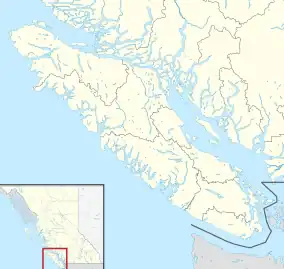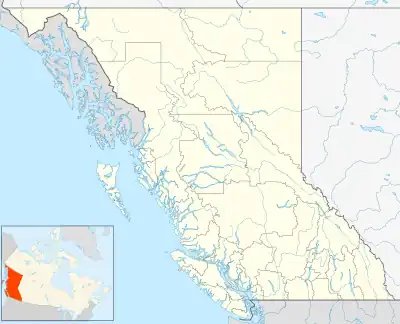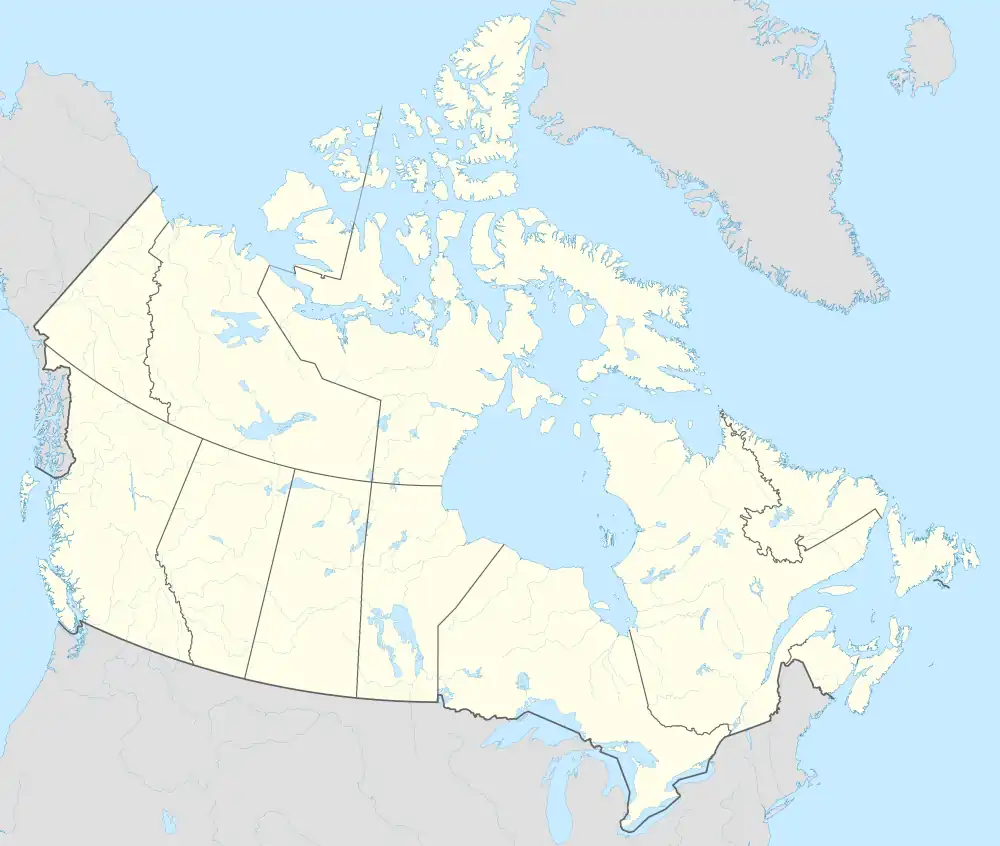Tofino
Tofino (/təˈfiːnoʊ/ ⓘ tə-FEE-noh) is a town of approximately 2,516 residents on the west coast of Vancouver Island in the Canadian province of British Columbia. The District of Tofino is located at the western terminus of Highway 4 on the tip of the Esowista Peninsula at the southern edge of Clayoquot Sound. It is situated in the traditional territory of the Tla-o-qui-aht First Nations.
Tofino | |
|---|---|
| District of Tofino[1] | |
 View toward Meares Island | |
 Tofino Location of Tofino  Tofino Tofino (British Columbia)  Tofino Tofino (Canada) | |
| Coordinates: 49°09′11″N 125°54′16″W[2] | |
| Country | Canada |
| Province | British Columbia |
| Regional District | Alberni-Clayoquot |
| Incorporated | 1932 |
| Government | |
| • Mayor | Dan Law |
| • MP | Gord Johns |
| • MLA | Josie Osborne |
| Area | |
| • Total | 10.53 km2 (4.07 sq mi) |
| Elevation | 10 m (30 ft) |
| Population (2021) | |
| • Total | 2,516 |
| • Density | 238.3/km2 (617/sq mi) |
| Time zone | UTC−08:00 (PST) |
| • Summer (DST) | UTC−07:00 (PDT) |
| Postal code span | V0R 2Z0 |
| Area code | 250 |
| Climate | Cfb |
| Website | tofino |
A popular year-round tourism destination, Tofino's summer population swells to many times its winter size. It attracts surfers, hikers, nature lovers, bird watchers, campers, whale watchers, fishers, or anyone just looking to be close to nature. Despite its small population, the town attracts a number of chefs and culinary professionals, which has resulted in a burgeoning choice of restaurants and specialty shops. In the winter, it is not as bustling, although many people visit Tofino and the West Coast to watch storms on the water. Close to Tofino is Long Beach, a scenic and popular year-round destination, in Pacific Rim National Park Reserve. With its natural hot springs, Maquinna Marine Provincial Park[4] is a popular day-trip destination for tourists. Reachable by boat or floatplane, the park is located about 45 km (28 mi) north of Tofino.
Etymology

The settlement acquired its name in 1909 with the opening of the Tofino Post Office, named after the nearby Tofino Inlet.[5] This geographical feature had been named in 1792 by the Spanish explorers Galiano and Valdés, in honour of Admiral Vicente Tofiño de San Miguel y Wanderiales (or Vanderiales), under whom Galiano had learned cartography.[6]
Demographics
In the 2021 Census of Population conducted by Statistics Canada, Tofino had a population of 2,516 living in 945 of its 1,205 total private dwellings, a change of 27.9% from its 2016 population of 1,967. With a land area of 10.56 km2 (4.08 sq mi), it had a population density of 238.3/km2 (617.1/sq mi) in 2021.[7]
Religion
According to the 2021 census, religious groups in Tofino included:[8]
- Irreligion (1,795 persons or 80.5%)
- Christianity (385 persons or 17.3%)
- Indigenous Spirituality (10 persons or 0.4%)
- Other (10 persons or 0.4%)
Transportation
Tofino/Long Beach Airport (YAZ), 6 nautical miles (11 km; 6.9 mi) southeast[9] of the town, is accessible to private and commercial aircraft. Floatplanes land on the inlet in town. Coastal fog is a common morning phenomenon in the summer, complicating access by air until the weather clears.
Tofino is located at the western end of Highway 4 that connects the community with Port Alberni and the population centres on the east coast of Vancouver Island. There are no roads connecting Tofino along the west coast of Vancouver Island, except to the nearby community of Ucluelet. A monument in the city declares Tofino to be the western terminus of the Trans-Canada Highway as part of a 1940s campaign by local residents; the highway ends instead in Victoria at the terminus of Highway 1.[10]
Boat services connect Tofino with coastal communities such as Ahousat and Hot Springs Cove. Wildlife-watching tour boats operate in the area. In October 2015, a whale watching vessel capsized off the coast of Tofino, which resulted in the deaths of six passengers.
Culture
Festivities and events

Every March, the migration of thousands of grey whales is celebrated with the Pacific Rim Whale Festival. The last weekend of April has, up until 2020, been the Tofino Shorebird Festival. The first weekend of June, for 14 years, brought the Tofino Food and Wine Festival, featuring British Columbia wines and showcasing the creations of Tofino chefs. The Tofino Market takes place on the Village Green on every Saturday, from the Victoria Day long weekend through early October. The Tofino Lantern Festival (voted Tofino's most popular event by Tofino Time Magazine), was a Raincoast Education Society fundraiser each August, with its cancellation announced in 2021. Since 2018, early September has the week-long Race for The Blue Tuna Shoot-Out[11] hosted by Tofino Resort + Marina, and Queen of the Peak Women's Surf Championship typically takes place toward the end of the month.[12] In 2010, the O'Neill Coldwater Surf Classic took place on Cox Bay Beach, as the first professional ASP surf event ever held in Canada, with Tofino surfer Pete Devries winning the competition.[13] November has typically hosted the Clayoquot Oyster Festival,.[14] Rip Curl Pro Tofino, the official Canadian surfing championship, has been held each year in May, since 2007.[15]
Poole's Land
Between 1988 and 2020, Tofino was home to Poole's Land, an ecovillage and "Hippie Commune" run on Anarchist principles. The Commune provided free accommodation to seasonal workers who would come to Tofino in the summer months as well as being a centre of counterculture in the region.
Freedom Cove
Located within the Tofino vicinity is the man-made floating Island of Freedom Cove. Constructed by Wayne Adams and Catherine King in 1992, the mostly wooden structure is both home to Adams and King as well as a tourist attraction and an art gallery. Freedom Cove attempts to live as sustainably as possible by such means as by using solar power, recycling waste, composting, drinking rainwater, and eating locally grown or caught food.[16][17][18]
Climate
The climate is marine west coast (Köppen: Cfb, clearly included in the temperate zone). Precipitation is concentrated in the winter, which is a characteristic of Coastal British Columbia; however, the annual amount of 3,270.7 mm (128.77 in) far exceeds nearby areas. By comparison, Victoria, British Columbia, which is located only 203 km (126 mi) away, receives only 607.6 mm (23.92 in).
Proximity to the Pacific Ocean keeps temperatures cool in the summer and mild in the winter. Average high temperatures in the summer and winter are relatively stable and cool, coming in at 19.1 °C (66.4 °F) and 8.1 °C (46.6 °F), respectively. Compared to the Canadian city of Winnipeg, Manitoba, which rests on a similar latitude, Tofino's average high temperature is 6.8 degrees cooler in the summer and a whopping 19.4 degrees warmer in the winter.
During the cooler season, there is a lot of precipitation, with 492.1 mm (19.37 in) in November alone. Nearly all of the precipitation that falls throughout the year is rain, with 203 days with rain and only 7.8 days with snowfall. Due to its location on the westernmost part of Vancouver Island, Tofino faces the Pacific Ocean, unimpeded by any mountains to the west (and therefore not subject to a rain shadow effect like much of the eastern island and the BC interior). Winter cyclonic storms frequently pass over the town deluging it with rain, making it one of the wettest locations in Canada. The month of November alone brings more precipitation to Tofino than that received for an entire year in parts of the BC interior such as Kamloops and Penticton.[19] Like the rest of coastal BC, summer brings relative dryness; even so, it still receives much more summertime precipitation than the interior (which can often be susceptible to drought-like conditions until the onset of autumn).[19]
The highest temperature ever recorded in Tofino was 33.9 °C (93.0 °F) on July 15, 1941.[20] The coldest temperature ever recorded was −15.0 °C (5.0 °F) on January 30, 1969.[21]
| Climate data for Tofino (Tofino/Long Beach Airport) Climate OD: 1038205; coordinates 49°04′56″N 125°46′21″W; elevation: 24.5 m (80 ft); 1981–2010 normals, extremes 1896–present[lower-alpha 1] | |||||||||||||
|---|---|---|---|---|---|---|---|---|---|---|---|---|---|
| Month | Jan | Feb | Mar | Apr | May | Jun | Jul | Aug | Sep | Oct | Nov | Dec | Year |
| Record high humidex | 18.3 | 18.4 | 18.1 | 23.0 | 27.6 | 32.9 | 35.5 | 42.7 | 33.6 | 25.9 | 20.6 | 15.2 | 42.7 |
| Record high °C (°F) | 20.1 (68.2) |
19.4 (66.9) |
19.4 (66.9) |
24.4 (75.9) |
29.4 (84.9) |
32.2 (90.0) |
33.9 (93.0) |
32.8 (91.0) |
29.4 (84.9) |
25.6 (78.1) |
21.1 (70.0) |
19.4 (66.9) |
33.9 (93.0) |
| Average high °C (°F) | 8.3 (46.9) |
9.0 (48.2) |
10.1 (50.2) |
11.9 (53.4) |
14.5 (58.1) |
16.8 (62.2) |
18.9 (66.0) |
19.1 (66.4) |
17.8 (64.0) |
13.6 (56.5) |
10.0 (50.0) |
8.1 (46.6) |
13.2 (55.8) |
| Daily mean °C (°F) | 5.3 (41.5) |
5.4 (41.7) |
6.5 (43.7) |
8.0 (46.4) |
10.5 (50.9) |
12.9 (55.2) |
14.7 (58.5) |
15.0 (59.0) |
13.4 (56.1) |
10.0 (50.0) |
6.8 (44.2) |
5.0 (41.0) |
9.5 (49.1) |
| Average low °C (°F) | 2.3 (36.1) |
1.9 (35.4) |
2.7 (36.9) |
4.0 (39.2) |
6.5 (43.7) |
8.9 (48.0) |
10.5 (50.9) |
10.8 (51.4) |
9.0 (48.2) |
6.3 (43.3) |
3.6 (38.5) |
1.9 (35.4) |
5.7 (42.3) |
| Record low °C (°F) | −15.0 (5.0) |
−11.1 (12.0) |
−6.1 (21.0) |
−3.3 (26.1) |
−1.1 (30.0) |
1.1 (34.0) |
3.3 (37.9) |
3.3 (37.9) |
−0.6 (30.9) |
−3.5 (25.7) |
−12.7 (9.1) |
−12.2 (10.0) |
−15.0 (5.0) |
| Record low wind chill | −18 | −17 | −9 | −6 | 0 | 0 | 0 | 0 | 0 | −6 | −14 | −16 | −18 |
| Average precipitation mm (inches) | 486.6 (19.16) |
336.1 (13.23) |
329.8 (12.98) |
269.9 (10.63) |
153.0 (6.02) |
129.7 (5.11) |
71.0 (2.80) |
88.1 (3.47) |
132.8 (5.23) |
341.9 (13.46) |
492.1 (19.37) |
440.0 (17.32) |
3,270.7 (128.77) |
| Average rainfall mm (inches) | 477.4 (18.80) |
327.3 (12.89) |
325.7 (12.82) |
269.2 (10.60) |
153.0 (6.02) |
129.7 (5.11) |
71.0 (2.80) |
88.1 (3.47) |
132.8 (5.23) |
341.8 (13.46) |
489.4 (19.27) |
432.0 (17.01) |
3,237.2 (127.45) |
| Average snowfall cm (inches) | 9.2 (3.6) |
8.7 (3.4) |
4.0 (1.6) |
0.7 (0.3) |
0 (0) |
0 (0) |
0 (0) |
0 (0) |
0 (0) |
0.1 (0.0) |
2.8 (1.1) |
7.9 (3.1) |
33.3 (13.1) |
| Average precipitation days (≥ 0.2 mm) | 22.7 | 18.7 | 21.7 | 18.4 | 15.7 | 13.8 | 10.0 | 10.9 | 11.7 | 19.4 | 22.9 | 21.9 | 207.8 |
| Average rainy days (≥ 0.2 mm) | 22.1 | 18.4 | 21.5 | 18.4 | 15.7 | 13.8 | 10.0 | 10.9 | 11.7 | 19.4 | 22.6 | 21.6 | 205.9 |
| Average snowy days (≥ 0.2 cm) | 1.9 | 1.5 | 1.3 | 0.4 | 0 | 0 | 0 | 0 | 0 | 0 | 0.9 | 2.0 | 7.8 |
| Average relative humidity (%) | 83.6 | 76.7 | 75.6 | 73.2 | 71.3 | 71.7 | 71.7 | 74.8 | 73.2 | 79.3 | 82.9 | 84.6 | 76.5 |
| Mean monthly sunshine hours | 58.6 | 81.6 | 126.3 | 170.3 | 203.1 | 190.9 | 226.7 | 199.6 | 175.8 | 116.1 | 62.5 | 56.5 | 1,668.1 |
| Percent possible sunshine | 21.7 | 28.5 | 34.3 | 41.5 | 42.9 | 39.4 | 46.4 | 44.8 | 46.4 | 34.6 | 22.7 | 22.0 | 35.4 |
| Source: Environment and Climate Change Canada[21][22] | |||||||||||||

Telecommunications
Tofino has modern cell phone and land line access (including Internet and ADSL).
Media
Tofino has one newspaper, the Tofino-Ucluelet Westerly News. Tofino Time is a monthly magazine that publishes local new and articles about Tofino and the surrounding areas. CHMZ-FM on 90.1 FM, nicknamed Tuff City radio, is a local radio station. Tofino also receives CBC Radio One via CBXZ-FM on 91.5 FM.
Health and education
Public education is offered by the School District 70 Alberni, through the Wickaninnish Community School in Tofino and Ucluelet Secondary School in Ucluelet. The town's hospital is the Tofino General Hospital, operated by the Vancouver Island Health Authority (VIHA).[23]
Cultural references
Music
- Montreal third wave ska band The Planet Smashers recorded a song on their album Life of the Party entitled "Surfin' in Tofino".[24]
- Canadian band Prairie Dance Club recorded a song entitled "Tofino".[25]
Film and television
- Tofino was a filming location for The Twilight Saga: New Moon in March and April 2009. South Beach, located near Wickaninnish Beach inside Pacific Rim National Park Reserve, and Incinerator Rock at Long Beach were used.[26]
- Tofino was also a filming location for the third installment of the new Planet of the Apes movie series called War for the Planet of the Apes. Long Beach and surrounding areas inside Pacific Rim National Park were used as filming locations.[27]
- In the Canadian film One Week, main character Ben Tyler (played by Joshua Jackson) rides his motorcycle from Toronto, Ontario to Tofino, British Columbia.[28]
- Tofino was one of the many filming locations for the movie The Big Year starring Jack Black, Owen Wilson and Steve Martin. It filmed several scenes in the town of Tofino at Schooner Restaurant and 4th street dock in the harbour.[29]
- Going the Distance, a 2004 teen comedy film with a group of friends going on a road-trip starting from Tofino beach heading to Toronto.[30]
Notable people
- Andrew Oye (born May 10, 1974), composer
References
- "British Columbia Regional Districts, Municipalities, Corporate Name, Date of Incorporation and Postal Address" (XLS). British Columbia Ministry of Communities, Sport and Cultural Development. Retrieved November 2, 2014.
- "Tofino". Geographical Names Data Base. Natural Resources Canada.
- "Tofino". Geographical Names Data Base. Natural Resources Canada.
- "redirect". Archived from the original on March 4, 2016. Retrieved April 7, 2016.
- "Tofino". BC Geographical Names.
- Dionisio Alcalá Galiano: The Canadian Adventure of a Spanish Naval Hero, Malaspina University-College
- "Population and dwelling counts: Canada, provinces and territories, and census subdivisions (municipalities), British Columbia". Statistics Canada. February 9, 2022. Retrieved February 20, 2022.
- Government of Canada, Statistics Canada (October 26, 2022). "Census Profile, 2021 Census of Population". www12.statcan.gc.ca. Retrieved November 11, 2022.
- Canada Flight Supplement. Effective 0901Z 16 July 2020 to 0901Z 10 September 2020.
- Fuhrmann, Mike (July 29, 2012). "Road across Canada ends in Tofino, locals say". Times Colonist. Retrieved December 6, 2022.
- "Blue Tuna Shoot-Out". Tofino Resort + Marina. Retrieved September 16, 2018.
- Tapp, Fiona. "Learn To Surf At The World's Largest Female-Only Instructor Surf School". Forbes. Retrieved May 19, 2021.
- Windh, Jacqueline (November 2, 2009). "How a Tofino Guy Earned a Surfing Crown". The Tyee. Retrieved May 19, 2021.
- Trefler, C., ed. (2008). Fodor's Vancouver and Victoria (illustrated ed.). Fodor's Travel Publications. p. 262. ISBN 978-1400019182.
- "Rip Curl Pro Tofino - Announces Dates for 2017". Rip Curl. Retrieved May 16, 2017.
- "Freedom Cove, B.C. Float Home, Is A Whole New Level Of Off-Grid Living". Retrieved July 6, 2020.
- "Freedom Cove A floating sanctuary provides artistic inspiration". Retrieved July 6, 2020.
- "Living on water: Welcome to Freedom Cove". Retrieved July 6, 2020.
- "Canadian Climate Normals 1971-2000". Environment and Climate Change Canada. Retrieved February 16, 2011.
- "Daily Data Report for July 1941". Environment and Climate Change Canada. October 31, 2011. Retrieved March 3, 2017.
- "Canadian Climate Normals 1981-2010 Station Data". Environment and Climate Change Canada. September 25, 2013. Retrieved March 3, 2017.
- "Clayoquot". Environment and Climate Change Canada. October 31, 2011. Retrieved March 3, 2017.
- Tofino General Hospital. Retrieved October 24, 2011
- Huey, Steve. "The Life of the Party". AllMusic. Retrieved April 7, 2016.
- "Prairie Dance Club - Prairie Dance Club | Songs, Reviews, Credits | AllMusic". AllMusic. Retrieved September 30, 2018.
- Drews, Keven (March 23, 2009). "Tofino provides perfect setting for Twilight's vampires". The Globe and Mail. Retrieved April 7, 2016.
- "Long Beach Lodge Resort Tofino | Apes invade Tofino!". www.longbeachlodgeresort.com. Retrieved June 27, 2019.
- Quill, Greg (March 6, 2009). "One Week: Canada rides along on this odyssey | The Star". The Toronto Star. Retrieved June 27, 2019.
- Drews, Keven (April 13, 2010). "Steve Martin, Jack Black, Owen Wilson have Tofino chef checking recipes". CP24. Retrieved June 27, 2019.
- "Going the Distance (2004)". Retrieved September 17, 2022.
- Extreme high and low temperatures in the table below were recorded at Clayoquot from December 1896 to June 1943 and at Tofino Airport from July 1943 to present.
External links
 Media related to Category:Tofino at Wikimedia Commons
Media related to Category:Tofino at Wikimedia Commons- Official website

 Tofino travel guide from Wikivoyage
Tofino travel guide from Wikivoyage